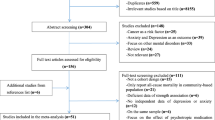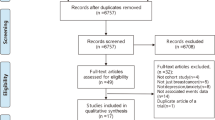Abstract
The Hospital Anxiety and Depression (HAD) scale, a self-report questionnaire, was tested as a method of identifying mood disorder among patients with operable breast cancer during the year after diagnosis. In a cohort of 91 patients anxiety and depression were assessed preoperatively, and at 3 and 12 months post-operatively, using a standardised psychiatric interview and diagnostic rating criteria. The patients also completed the HAD scale at each assessment. Fifty out of 91 (55%) patients were full or borderline cases of depression and/or anxiety at one or more assessment points. Using a receiver operator characteristic curve analysis, the optimum threshold for the preoperative HAD scale total score to identify psychiatric disorder either preoperatively or at 3 and 12 months post-operatively was 11. With this threshold 70% of both full and borderline cases occurring at any of the assessment points were correctly identified. The false-positive rate was 12%. This approach was particularly sensitive to full cases, correctly identifying 90% of them. The potential for the preoperative HAD scale total score to identify mood disorder in the year after diagnosis was influenced by age. Among women aged less than 50 years, a preoperative HAD scale total score > or = 11 provided a highly sensitive indicator of mood disorder (full and borderline cases) at any time in the year after diagnosis (sensitivity = 90%). The false-positive rate was 40%. Among women older than 50 who experienced a mood disorder, only 57% were correctly identified by a HAD scale total score of > or = 11 (sensitivity = 57%). However, the false-positive rate among older women was low (3%). This simple preoperative screening approach can be used to identify patients who have or are at high risk of developing severe mood disorder in the year after diagnosis. The HAD scale is also sensitive to the detection of borderline mood disorder in patients under the age of 50. It is a specific screening tool among patients over 50, but is not sensitive to the detection of borderline mood disorder in this age group.
This is a preview of subscription content, access via your institution
Access options
Subscribe to this journal
Receive 24 print issues and online access
$259.00 per year
only $10.79 per issue
Buy this article
- Purchase on Springer Link
- Instant access to full article PDF
Prices may be subject to local taxes which are calculated during checkout
Similar content being viewed by others
Author information
Authors and Affiliations
Rights and permissions
About this article
Cite this article
Ramirez, A., Richards, M., Jarrett, S. et al. Can mood disorder in women with breast cancer be identified preoperatively?. Br J Cancer 72, 1509–1512 (1995). https://doi.org/10.1038/bjc.1995.538
Issue Date:
DOI: https://doi.org/10.1038/bjc.1995.538
This article is cited by
-
Accuracy of the Hospital Anxiety and Depression Scale as a screening tool in cancer patients: a systematic review and meta-analysis
Supportive Care in Cancer (2011)
-
Depression, quality of life and breast cancer: a review of the literature
Breast Cancer Research and Treatment (2008)
-
An investigation into the psychometric properties of the Hospital Anxiety and Depression Scale in patients with breast cancer
Health and Quality of Life Outcomes (2005)
-
Major depression in outpatients attending a regional cancer centre: screening and unmet treatment needs
British Journal of Cancer (2004)



